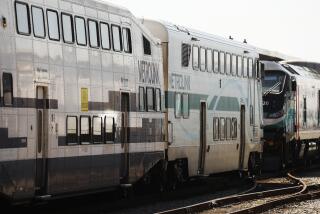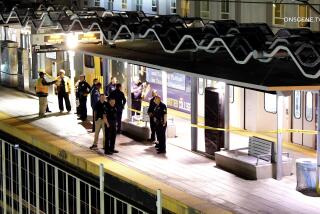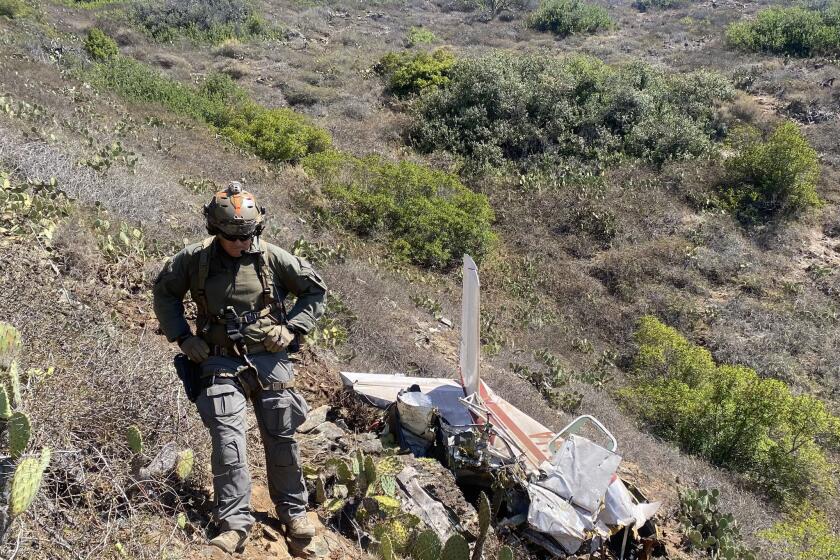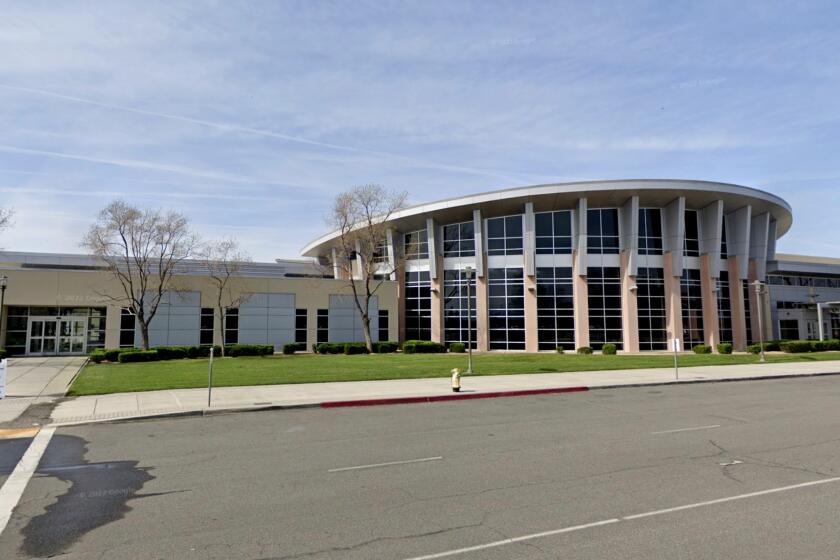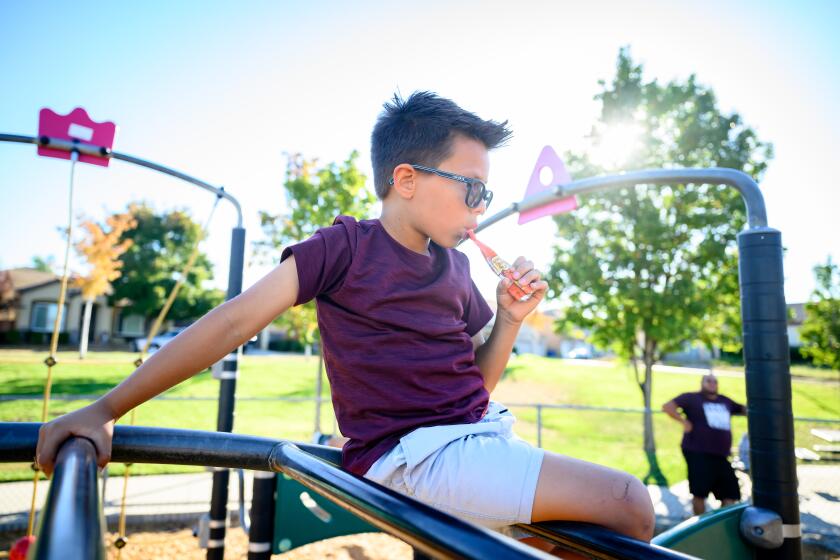Cabbie in Crash That Killed 6 Had No License
A driver whose taxi was crushed by a Blue Line train in Compton, killing all six in the car, had two convictions for drunken driving, was driving with a suspended license and had no permit to operate a taxi in Compton, authorities said Monday.
The driver, 42-year-old Romaldo Gonzalez, may have used a radio scanner to intercept a dispatcher’s call from a licensed cab company late Saturday. He then apparently zigzagged around a crossing gate and tried to outrun a southbound train, which blew its horn to no avail. His passengers included three brothers and a woman returning home from a party nearby. The sixth victim was an unidentified woman.
It was the latest of many accidents in which cars have been struck by trains along the busy Los Angeles-Long Beach light rail line.
The crash, on Greenleaf Boulevard at Willowbrook Avenue, highlighted not only the ongoing problem of drivers trying to outrun light rail trains but also the danger posed by unlicensed taxi drivers, who can be all but indistinguishable from legitimate cabbies.
“It’s an extremely serious problem,” said Tom Drischler, the taxicab administrator for the city of Los Angeles. He said there are dozens of companies and thousands of vehicles operating illegally throughout Southern California.
Gonzalez was convicted of drunk driving in 1992, and again on Nov. 6, 1998, according to the state Department of Motor Vehicles. As a result of the second conviction, his license was suspended for 18 months, beginning Dec. 4, 1998.
Gonzalez’s mother and brother conceded that he had had a drinking problem, but said he had not been drinking for the last five or six months. Scott Carrier, a spokesman for the Los Angeles County coroner, said it would be six to eight weeks before toxicology tests could determine whether Gonzalez had been driving under the influence of drugs or alcohol.
Gonzalez did not have a permit to drive a cab in Compton, and did not legally own the cab he was driving, a yellow 1991 Chevrolet Caprice, according to Compton Police Lt. Danny Sneed. The cab was registered to a Lenin Chavez, who told investigators he had sold it to another man--not Gonzalez--about six months ago, but had never transferred the title.
A woman who identified herself as Gonzalez’s wife said he had purchased the taxi two weeks ago, according to a television news report. Sneed said only that police believe he bought it recently.
Sneed said Gonzalez was believed to have been working independently. The driver’s mother, Esperanza Jaimez Negrete, and half-brother, Bruno Chavez, said he was working for Duarte Yellow Cab Co. They said the company had dispatched him to pick up the passengers who died Saturday night.
A man who answered the phone at a number listed for Duarte Yellow Cab but would not give his name said the company had changed owners and was now called Compton Yellow Cab. He said Gonzalez used to work for the company, but stopped when the ownership changed.
Other accounts tend to support the police version of events.
The aunt of one passenger said she had made the call that night--not to Duarte Yellow Cab, but to Main City Taxi. A dispatcher at Main City Taxi, Jose Saenz, said he had taken the call and dispatched a cab, but that when the driver reached the destination, the passengers had already been picked up. He speculated that Gonzalez had used a scanner to intercept the radio call and beat the Main City cab to the pickup site.
Chavez and Negrete claimed that Gonzalez had leased, not purchased, the cab. Because of his suspended license, he had put the lease in the name of a girlfriend who had a valid driver’s license, they said.
The girlfriend was among those killed in the crash, they said. The coroner’s office said that one female passenger had been burned beyond recognition, and that investigators were waiting for dental charts to identify her.
Those known to have died, besides Gonzalez, were brothers Luis Davila, 26; Sergio Davila, 22; and Jesus Davila, 19, of Long Beach; and Sara Rodriguez, 17, of Compton, who was the girlfriend of one of the brothers.
Paul Lennon, the Metropolitan Transportation Authority’s managing director of safety and security, said the agency and law enforcement are doing everything possible to prevent fatalities along the 22-mile Blue Line. But, he said, it is difficult to stop a motorist who is determined to go around a crossing gate to beat a train.
“Could this happen again?” Lennon asked at a news conference. “Yes, under those circumstances.”
Lennon said the Blue Line has tried to improve safety, establishing education programs for the public and supporting recent legislation that will increase fines for crossing-gate violations from $103 to $271 in January.
The MTA, he said, has plans to install photographic equipment at 10 more locations along the line to take pictures of offending motorists and their vehicles. The MTA now has 17 Blue Line sites equipped for cameras, including the Greenleaf intersection where the accident occurred. However, MTA spokesman Ed Scannell said there was no camera in place at that crossing Saturday night.
Lennon said the authority is considering better warning signs and gate designs that are harder for people and vehicles to get around.
“There is one point I would like to make out of all of this,” Lennon said. “If you elect to go around a crossing gate, you are putting your life at serious risk.”
Since the Blue Line opened in July 1990, 53 people, 22 in cars and 31 on foot, have been killed in accidents involving the rail system, according to MTA statistics. Ten people died in 1998 and 10 have died so far this year.
Honeywell Inc. is testing a radar scanner at one Blue Line intersection where the MTA has installed a four-section gate that makes crossing extremely difficult. The scanner could alert train operators to an obstruction at an upcoming intersection, Honeywell spokesman Bryce Hallowell said.
Los Angeles County Sheriff’s Department officials, who are responsible for traffic safety along the Blue Line, said the fatal crash illustrates the difficulties of operating a commuter rail system in a densely populated urban area.
“People trying to beat the crossing gate is a regular occurrence,” said Sgt. Ann Ramirez, who is assigned to Blue Line rail operations. “It goes on more than you would imagine.”
The Sheriff’s Department has eight motorcycle officers, four officers in squad cars, and eight foot patrol officers assigned to the Blue Line. Ramirez said they are constantly citing pedestrians and motorists for violating crossing gates.
MTA officials said Blue Line trains continued to experience slight delays Monday while work crews repaired damaged ties at the accident site. For safety reasons, train speeds were reduced from 55 mph to 10 mph for a quarter-mile section of track.
The crash damaged 56 ties and knocked down a pole that helps support the Blue Line’s overhead electrical system. MTA officials said eight of the most seriously damaged ties have been repaired, allowing southbound trains to safely operate at slower speeds.
At a small demonstration near the accident site Monday, a few members of a group calling itself Ministers Against Metrorail Accidents demanded that the MTA take more rigorous measures to reduce accidents along the light rail line.
Times staff writer Dan Weikel contributed to this story.
More to Read
Sign up for Essential California
The most important California stories and recommendations in your inbox every morning.
You may occasionally receive promotional content from the Los Angeles Times.
